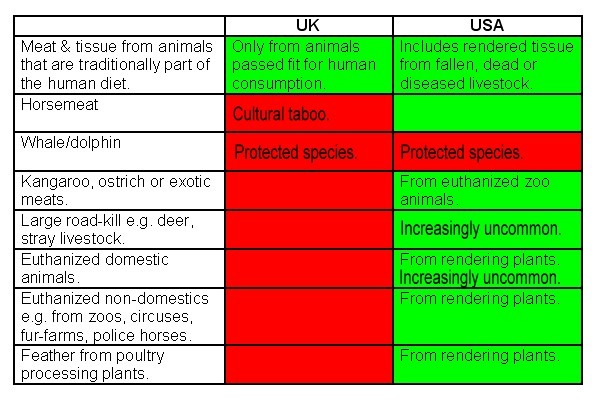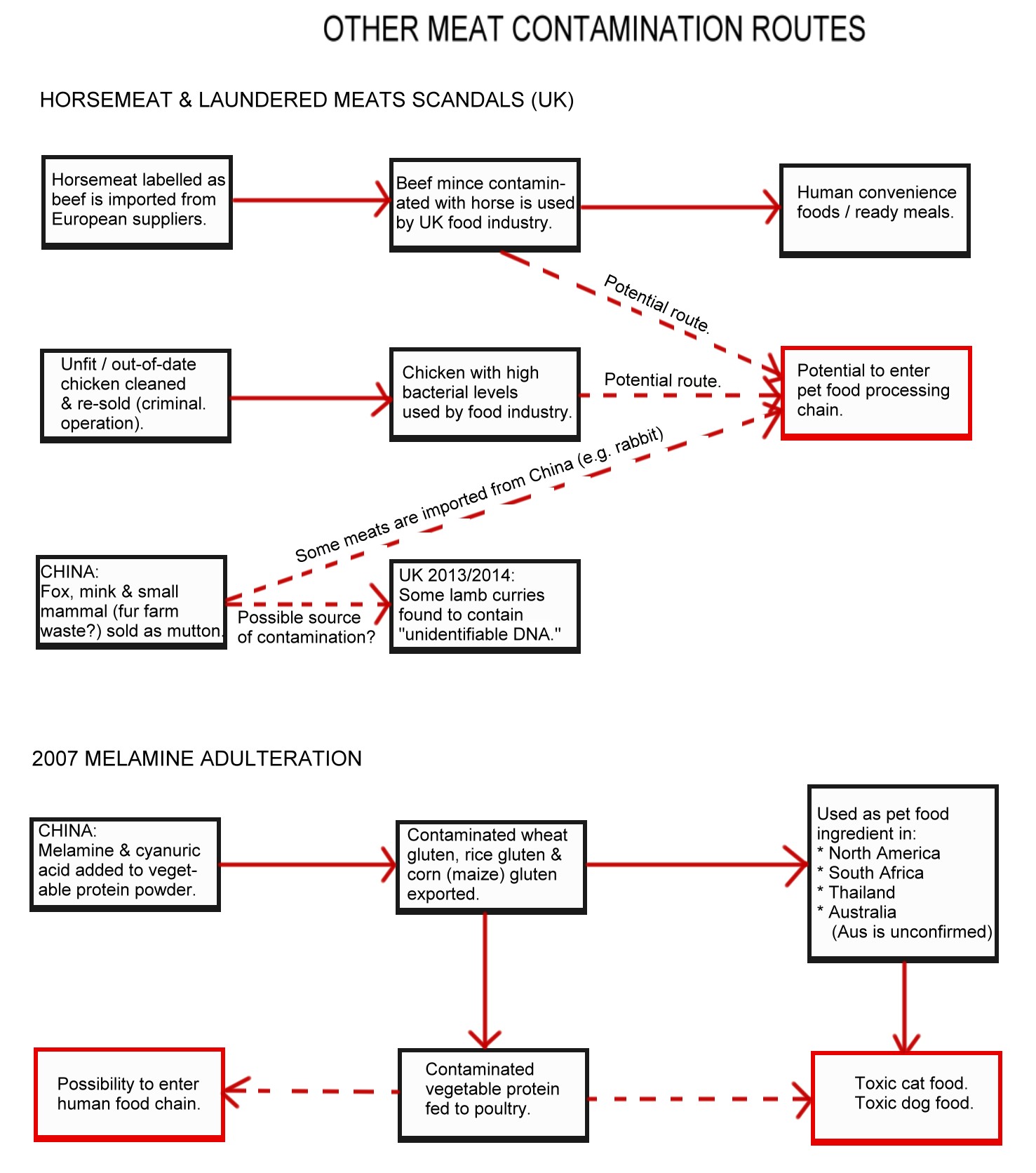
CAT FOOD CONTAMINATION
Details of cat food ingredients, additives and processing methods are covered in the article at Cat Food Uncovered. This article looks at contamination events that have led to product recalls.
In general, the meat-based ingredients used in cat foods are summarised in the table below. Various additives are used to give the products their texture, flavour and ensure correct vitamin, mineral and protein levels. Many of these additives are derived from vegetable sources (not a normal part of the feline diet!) and are manufactured in bulk. Compared to meat-based sources, they are cheap to use. They may be imported from countries whose quality control systems are less rigorous or where additives unsuitable for animal or human consumption are used illicitly.

2007 - MELAMINE
In Britain, the Pet Food Manufacturers Association adheres to a code of practice: all ingredients used in pet food must come from animals passed fit for human consumption and can only come from animals traditionally eat by humans in Britain. This means no horse/donkey meat, no whale meat and no kangaroo or ostrich meat. PFMA guidelines meant that tissues that can carry prion disease was eliminated from pet foods before being eliminated from human foods! In North America, pet food ingredients can include diseased or fallen livestock, horsemeat, large road-kill, euthanized zoo animals and even euthanized pets (and testing for BSE in cattle in the USA is so rare that it is a "head in the sand" approach). This is why I don't buy cat foods imported from the USA - in my opinion it doesn't meet the same ingredient quality standards as that produced in Britain.
Given these difference in ingredient quality, it's probably unsurprising that the biggest pet food contamination scandal originated in North America. It's also unsurprising that it was linked to vegetable protein. Cats are obligate carnivores. They did not evolve to metabolize vegetables and may not metabolize certain vegetable compounds in the way that omnivores or herbivores metabolize them. The cat's specialised digestive system makes them particularly susceptible to contaminants because they rely on their prey to break down and excrete potential toxins. Cats' livers don't cope well with contaminants and their kidneys have evolved to excrete concentrated urine and conserve liquids (in the wild, cats get most of their fluid intake from their prey). Vegetable proteins are cheaper than proteins derived from meat; they can be bought in bulk and are often used as thickeners and texturisers.
2007 Outbreak
In March 2007, a wide recall of many brands of cat and dog foods began in response to several weeks of reports of kidney failure in pets. The recall spread from North America to Europe and South Africa. At first, the recalled products were primarily canned foods made with wheat gluten imported from a single Chinese company. The Canadian-owned Menu Foods began the recall after their own tests confirmed sickness and death in animals fed on particular pet food. Over a three week period, customers had been complaining of kidney disease and death in pets fed on Menu Foods products. Contaminated rice protein from a different Chinese source was also linked to kidney failure in pets in the USA. Contaminated corn (maize) gluten was linked to kidney failure with pets in South Africa. This led to a broader investigation of Chinese proteins imported for use in both human and animals foodstuffs. By the end of March 2007, more than 500 cases of kidney failure, including 100 pet deaths had been reported. By April 3,600 pet deaths had been reported by pet owners, but the lack of a centralized database for animal disease meant the US Food and Drug Administration could only confirm 14 cases. More than 5000 pet food products were recalled as a result.
Initially, there was obfuscation of the information when the FDA's Office of Enforcement, denied that the agency knew of any additional forthcoming pet food recalls, yet only hours later, Costco and several other companies announced the recall of several brands of pet food initiated (according to Costco) because the FDA had found melamine adulteration. When there is a scare, companies reacted quickly – in part to avoid class action litigation should their products be found to contain contaminants.
The majority of recalled foods were from Menu Foods of Streetsville, Ontario; this represented over 40 brands of cat and over 50 brands of dog food. As a precautionary measure, they also recalled brands that used wheat gluten from other sources. A number of manufacturers recalled foods, regardless of whether any pet deaths had been linked to their products. According to the American Veterinary Medical Association (AVMA), recalled pet foods included some brands produced by globally known pet food manufacturers Nestlé Purina PetCare, Del Monte, Hill's Pet Nutrition and Royal Canin Canada/USA. Some of the foods concerned were specialised veterinary diets. The American Society for the Prevention of Cruelty to Animals (ASPCA) recommended that pets should be fed products containing only US-sourced protein supplements until the crisis was resolved. Public outrage and extensive media coverage led to calls for government regulation of the self-regulated pet food industry.
Investigation
In October 2007, the results of the "AAVLD survey of pet food-induced nephrotoxicity in North America, April to June 2007," reported that indicating 347 (235 being cats) out of 486 cases voluntarily reported by 6 June 2007 had met the diagnostic criteria. Most were reported from the United States, and a further 7 cats reported from Canada. 61% of affected cats studied were reported to have died. Animal studies have shown that melamine can lead to kidney stones and cancer. It can increase urine output when fed to dogs in large amounts and although there have been no studies in cats, adverse effects on feline kidneys (which evolved to conserve water and produce concentrated urine) would probably be worse than in dogs. Because cats evolved to digest animal protein and not vegetable protein, their obligate carnivore metabolism may mean melamine is particularly toxic to them. Even if melamine itself is not the causative agent, its presence may be linked to the causative agent and be a marker for another toxin. It is irrefutable that that the pets died after consuming foods in which melamine was found.
Initial efforts to identify the toxin had focussed on aminopterin as this was found in tissue samples. Affected animals' kidneys "demonstrating acute tubular necrosis in the kidney with intratubular crystals." Despite reports of aminopterin being a rodenticide, it has never been used in rat poison and actually has a low toxicity to rats. Aminopterin was (and is) illegal in China and further tests of affected animals ruled out aminopterin. Melamine was suspected after an "unnamed pet food company" reported finding an industrial chemical used in plastics manufacture, melamine, in their own internal testing of wheat gluten samples. It soon became clear the common factor in implicated pet foods was wheat gluten used to thicken gravy in some canned foods. This was quickly confirmed by testing tissue samples from dead pets and urine samples from dead or sick pets. Up to 6.6% of melamine, often visible as crystals, was found in the raw wheat gluten. Some products containing rice protein, but not wheat gluten, were also found to be contaminated with melamine. Corn (maize) gluten used in some South African pet foods was also contaminated.
The crystals in contaminated proteins were found to be a mix of melamine, cyanuric acid, ammelide and ammeline, Cyanuric acid, ammelide and ammeline are metabolites of melamine which could indicate bacterial contamination of the protein. Crystals found in the kidneys and urine of affected pets comprised mostly the almost insoluble metabolite cyanuric acid which caused acute renal failure in cats. It is possible that the combination of melamine and cyanuric acid is more toxic than the individual compounds. According to a report in the International Herald Tribune, some Chinese animal feed producers added cyanuric acid to give the false appearance of a higher level of protein. Chinese authorities later closed down Xuzhou Anying Biologic Technology Development Company and Binzhou Futian Biology Technology Company; the two companies linked to the contaminated products.Earlier Outbreaks
In 2004, more than 6,000 dogs and a lesser number of cats in Asia were killed or sickened by pet food that caused kidney failure. The outbreak was linked to foods manufactured in Thailand by Mars Inc. Vets in Asia initially blamed fungal toxins, but pathology tests conducted in 2007 found melamine and cyanuric acid present in preserved kidney tissue samples.
On 22 February 2006, Xinhua (a Chinese media source) reported at least 38 cats dying shortly after being fed with Xiduoyu, a brand of a "Tianjin-based cat food manufacturer". A veterinarian was reported as saying "test results from Beijing Animal Hospital showed the dead cats had suffered from kidney exhaustion and that the sick ones have kidney damage." Suspicions at that time focused on lead poisoning, not melamine contamination. Gu Junhua, a chief engineer from China's "national feedstuff quality check centre under the Ministry of Agriculture", was reported as saying: "It was difficult to draw any conclusions because the country has not drafted any food safety criteria for pets in terms of the quality and quantity of each element of the ingredients." No mention of melamine was made.
According to pathologists, the results indicated that the pet food–associated kidney failure outbreaks in 2004 and 2007 shared identical clinical, histologic, and toxicologic findings, providing compelling evidence that they were caused by the same toxin contaminating pet food.
